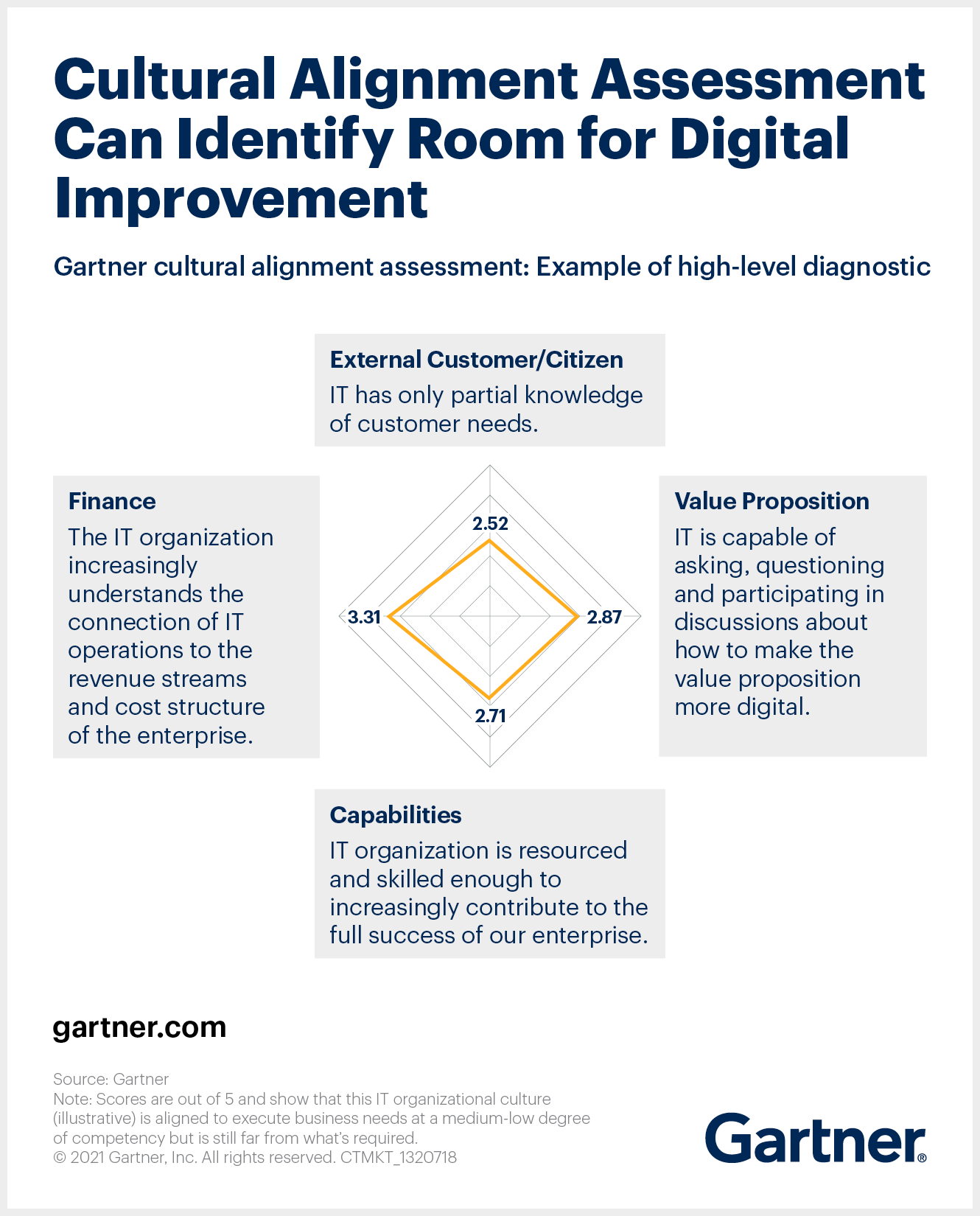COVID-19 and its effects accelerated digital business at an unprecedented pace, and CEOs continue to invest in digital capabilities as they look to take advantage of what many expect to be a fast, sharp recovery. CIOs and their IT teams are key to this digital strategy and execution, but is the IT organizational culture up to the task?
“Many CIOs recognize that the way IT employees get work done today isn’t what the enterprise needs to meet its digital ambitions, but few know how to get rid of stubborn, unproductive behaviors,” says Daniel Sanchez-Reina, VP Analyst, Gartner. “They need a rigorous way to gauge what needs to change.”
Download research: IT Roadmap for Digital Business Transformation
What is organizational culture?
Culture isn’t an academic construct. Culture is what drives the priorities of individuals within the organization. It comprises the behaviors and actions that have become normalized over time to dictate how work gets done and prioritized.
The question for CIOs is what behaviors and actions are needed to ensure that the IT organizational culture is aligned to drive digital transformation and acceleration.
As business models change, so do the behaviors and actions that are most relevant. It’s not surprising, then, that the IT organizational culture can increasingly lag behind what’s needed to drive digital ambitions. But CIOs must intentionally and actively diagnose and address these culture gaps.
If you allow misaligned behaviors and actions to become normalized, the way work gets done becomes less and less fit for delivering on priorities, now and in the future. Worse still, your IT organizational culture can actually jeopardize digital ambitions.
In short, an IT organizational culture fit for your digital ambitions must get and stay aligned to the stated objectives of the business model. But how do CIOs do that?
Is your IT culture in step with the business model and strategy?
To develop a digitally mature IT organizational culture, CIOs should first level-set on how responsive IT teams are to the four key components of the business model and its corresponding business strategy today:
- External customers/citizens: How knowledgeable and responsive the IT organization is to external customers/citizens/constituents, their industry/sector environment and the external factors affecting them
- Value proposition: How knowledgeable and responsive the IT organization is to the external product/service environment
- Capabilities: How the IT organization prepares, orchestrates and measures its capabilities (information, technology, people, skills, assets, ecosystem stakeholders) to accomplish its mission
- Finance: The IT organization’s knowledge of and responsiveness to overall enterprise finances (revenue sources, costs, risks, funding model, financial KPIs)
It’s also valuable to gauge the intensity of the IT organization in terms of its intentions (awareness and understanding of influential factors and environment) and actions (the team’s dedication to making things happen).
How fit is your IT organizational culture to drive digital ambitions?
Having assessed the degree of alignment with the business model, CIOs need to plot an improvement path for the IT organizational culture based on its current level of maturity. The Gartner assessment tool measures maturity on the following scale:
- Unaligned: Our IT culture isn’t aligned and isn’t aware that it’s not.
- Awakening: Our IT culture isn’t aligned but is somewhat aware that it’s not.
- Settling: Our IT culture is performing on digital business needs but is far from fully aligned.
- Aligned: Our IT culture is aligned with today’s digital business needs.
- Forward-looking: Our IT culture is aligned with today’s digital business needs and ready for the future.
The objective is to get to level 5. You might choose to stop at a lower level if you think you’ve already done the heavy lifting, but that will mean there’s still room for improvement. So even if you pause, continue escalating the cultural alignment when you see fit, knowing that lack of alignment threatens to hamper your progress in the interim.
Sample actions to shift the IT organizational culture for digital
Once your IT teams have completed a cultural assessment to gauge their digital fitness, you will need to act to close whatever gaps are critical to your digital success. Here are some examples of actions you might need to take.
External customers/citizens
Share specific information about how your enterprise segments external customers/citizens and why, and the different channels to reach them. Also, give them a clear picture of the industry and competitive landscape.
Value proposition
Organize a hackathon or quiz game among your team members, with specific questions about segmentations of products/services and their expected growth, the various channels your enterprise uses to deliver them, the main competitors in each segment and their competitive levers. Make it a quarterly ritual.
Capabilities
Share the IT strategy with team members and talk about strengths and weaknesses in organizational structure, technological resources, people’s skills and competencies, and interactions with the rest of the enterprise and external parties. Highlight what’s missing for the IT organization to drive the organization toward its digital goals.
Finance
Appoint “tiger teams” to assess how robust and flexible your IT budget is (in both its structure and content) to face foreseeable future needs. Share the conclusions with the entire department and devise a rationale to present to the CFO and CEO.
![]()
The post Can Your IT Team Culture Drive Your Digital Ambitions? appeared first on Smarter With Gartner.

